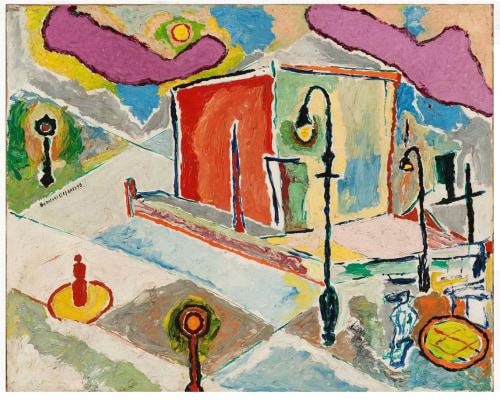
Beauford Delaney’s “Untitled” (1948). CreditBeauford Delaney, Michael Rosenfeld Gallery LLC, New York, NY
The Art Show, organized by the Art Dealers Association of America (ADAA) at the Park Avenue Armory, has the fair theme down to a science. Rather than fatigue-inducing roundups of mixed artists, most galleries here are devoting their booths to solo presentations. There is a strong African-American presence this year, many historical shows and a number of concept exhibitions. Alongside these are what might be called the post-retrospective reminder: a gathering of works that follow on the heels of an important museum show. Here are highlights from the 72 exhibitors.
Donald Morris
Continue reading the main story
RELATED COVERAGE
Art Review: What Not to Miss at the Armory Show at the PiersMARCH 3, 2016
Where to Go Now: A Guide to New York Art FairsMARCH 1, 2016
The Art Show is offering mini-shows of African-American painters such as Beauford Delaney (at Michael Rosenfeld), McArthur Binion (at Galerie Lelong) and Bill Traylor (at Betty Cuningham). Of particular note is the presentation of late, small-format paintings by Bob Thompson, which commemorates the 50th anniversary of that artist’s death at the age of 28. Thompson’s works at Donald Morris take European old master paintings as their inspiration, translating Boucher, Botticelli and a bevy of Dutch painters into compositions featuring flat, bright unmodulated color.
Haines Gallery
In the post-museum-retrospective category, Haines has a good selection of work by the nonagenarian Iranian artist Monir Farmanfarmaian, who had a show at the Guggenheim last year. Ms. Farmanfarmaian’s dazzling, mirrored sculptures and jewelry combine architecture, celestial geometry and Sufism with traditional Islamic craft techniques to produce a kaleidoscopic effect.
Dominique Lévy and Marianne Boesky
Another post-museum-retrospective presentation appears at the joined booths of two dealers with Upper East Side galleries, Lévy and Boesky. Frank Stella, whose megasurvey at the Whitney Museum of American Art closed in February, is represented by two cardboard constructions from his “Polish Village” series, inspired by traditional wooden synagogues. A museum show dedicated to Mr. Stella’s work on the same subject opened in Warsaw last month.
Hans P. Kraus Jr.
and Howard Greenberg
Two photography dealers have teamed up for an exhibition dedicated to the Photo-Secession, the group founded by Alfred Stieglitz in 1902 to promote photography as an art form in the United States. Photographs by Stieglitz, Gertrude Käsebier, Alvin Langdon Coburn and their contemporaries are hung alongside two canvases painted by Edward Steichen, a landscape and portrait of one of Stieglitz’s sisters, which are reminders that Steichen, a luminary of Pictorialist photography, started off as a painter.
Fraenkel
A smart show at Fraenkel links the oeuvre of Edward Hopper to 20th-century American photography. Hopper’s watercolor views of clapboard houses, electric lines and windswept landscapes are displayed alongside black-and-white photographs by Robert Adams, Diane Arbus and Lee Friedlander, as well Stephen Shore, a pioneer of color photography, whose works here eerily echo Hopper’s depictions of domestic architecture.
Hirschl & Adler
The contemporary artist Maria Elena González was also inspired by the American landscape, but in a very different way. Ms. González has translated the lines and striations in birch bark to create musical scores that can be played on a player piano. Live performances of her ongoing “Tree Talk” project, with the dark and atonal sounds of the birch trees, will take place in Hirschl & Adler’s booth at 2 and 6 p.m. Tthe scores are also played on a video in the booth.
Jack Tilton
New work created especially for the fair by Simone Leigh is on view. Ms. Leigh is showing a lineup (literally) of ceramic bust sculptures inspired by African art and female African-American traditions. Sleek glazed surfaces are juxtaposed with the patterns of curled and braided hair. Ms. Leigh’s fair sculptures follow on the heels of a major project: Last year she organized the Free People’s Medical Clinic in Bedford-Stuyvesant, Brooklyn, with African-American nurses volunteering to help underserved neighborhoods.
Mary Ryan
Hugo Gellert, featured here, also combined art with activism. A Hungarian immigrant who helped organize the Artists Union in the 1930s, Gellert is represented by a generous presentation of lithographs, paintings and illustrations, including his 1931 cover for New Masses magazine. A notable feature of his work was the representation of African-Americans alongside white Americans as peers rather than subservient figures, which is how African-Americans were often depicted during this period.
James Cohan
Trenton Doyle Hancock takes on the genre of the black superhero in his new paintings of a striped henchman, Torpedoboy and other figures invented by the artist. Mr. Hancock’s presentation at the fair coincides with several recent museum shows around the country. But his appearance on Park Avenue hasn’t stunted his irreverent approach, evident in titles like “Bloodshot eyes, trippy patterning, red, green, and yellow coloration. Yep, this piece must be about traffic lights” (2016) — a delirious composition that might also reference racial profiling and the prospect of “driving while black.”
Alexander Gray
Alexander Gray is in the vanguard of representing the estates of older and deceased artists. Here he presents drawings and paintings by Jack Tworkov (1900-1982), of the New York School. Instead of the slashing brush strokes and expressionist canvases of the ’50s, Gray is showing a suite of Tworkov’s works from the ’70s, inspired by the geometric grids and calculated moves of the knight on a chessboard. In the overall context of a fair that moves back and forth across history, with work by deceased artists that looks surprisingly contemporary and work by contemporaries that looks suspiciously historical, the booth is a good example of the topography and approach to “contemporary” art at the moment.